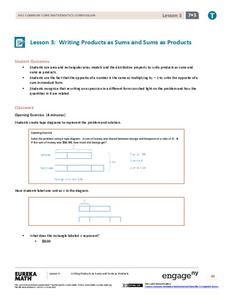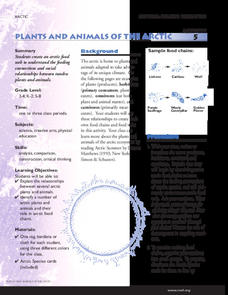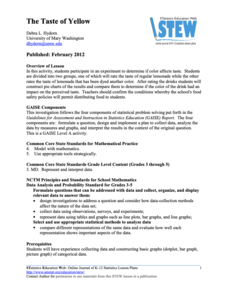Flipped Math
Calculus AB/BC - Limits at Infinity and Horizontal Asymptotes
Learning about end behavior means it's close to the end of the unit. The 16th of 18 lessons in Unit 1 - Limits and Continuity has scholars watch a video to learn how limits at infinity can be used to determine horizontal asymptotes and...
DiscoverE
DiscoverE Challenge: Pen Factory
Manufacture a great lesson on industrial manufacturing. A fun resource has learners use the production of pens to consider how assembly lines work. They write out a set of instructions for assembling a pen, test it out, then determine if...
DiscoverE
At Home: Safe Landing Activity
A parachute is probably a good idea. An engaging lesson has pupils brainstorm ways to slow the descent of a falling object to minimize the impact when it lands. They decide on a design, build a prototype, test it out, and then make...
Jane Addams Project
Woman Suffrage
Suffragettes, suffragists, and anti-suffragists. A two-day, richly detailed lesson plan has young historians investigate the twentieth-century suffrage movement. Groups examine primary and secondary source materials about Jane Addams and...
Bonneville
A Plan for Renewable Energy Goals
The best laid plans can lead to meeting renewable energy goals. A culminating project for the unit has pupils research the amount of solar and wind energy at their locations. They set renewable energy goals and use the information they...
EngageNY
Area Problems with Circular Regions
Uncover strategies for finding areas of composite figures. The 23rd lesson in a 29-part module has young mathematicians decompose figures to find total area. Figures decompose to rectangles and circular regions.
EngageNY
Collecting Rational Number Like Terms
Teach pupils to handle fractions fluently. The sixth installment in the series of 28 has class members apply the concepts learned in previous lessons to expressions with fractional coefficients. The fractions are both mixed numbers and...
EngageNY
Writing Products as Sums and Sums as Products
Create rectangle and area models to help students understand expressions. The third installment in the 28-part series has pupils first represent expressions using rectangular array models. The exercises help scholars understand the...
NOAA
Journey to the Unknown
Go where no one has gone before. Learners experience what it is like to be a scientist exploring new territory. Using audio and a scripted text, pupils take a trip in the depths of the ocean. They follow their trip with a hands-on...
Kiz Club
Alphabet Train
All aboard the alphabet express! Practice the ABC's with a cute set of train cars, each with one uppercase letter. An additional set of train cars features one lowercase letter per train car. The first set contains four cars per...
Pingry School
Effect of Solutes on Boiling Point
Anyone that lives around snow knows that adding salts to water increases its melting point. Are there solutes that affect the boiling point as well? A scientific experiment has learners add different solutes to water and then...
Benjamin Franklin Tercentenary
What Good May I Do: Franklin and the American Civic Association
Benjamin Franklin may have been a Founding Father of the United States, but he also founded a number of civic associations. Learners explore his legacy using a biographical essay and collaborative activity. After their exploration,...
National Wildlife Federation
Plants and Animals of the Arctic
The Arctic food web may be more limited than other environments, but it has all the same components. With an interactive activity, pupils assume the roles of the components of an Arctic food chain. They move around and link themselves to...
National Wildlife Federation
Go with the Flow
The quality of a watershed has a direct impact on the community it services. Learners study their own watershed using a topographical map. They recreate the watershed components using colored pencils to track the upstream and downstream...
National Wildlife Federation
Call of the Wild: Grades K-4
The sound a frog makes lets people know what it's up to. A two-part lesson begins by discussing the life cycle of a frog and the individual stages with drawings. The second part has learners listen to the frogs' different sounds and what...
National Wildlife Federation
Soil Decomposers
Worms are the kings of the decomposers. A four-part lesson has learners experiment with the characteristics of earthworms and their sensitivities. They vary factors such as light, acidity, temperature, and touch of soil and observe the...
National Wildlife Federation
Build a Bat House!
Bats usually get a bad rap. Scholars learn about the importance of bats and the threat their declining population has on the environment. They then build bat houses to attract and welcome bats into the area.
Curated OER
Write the Missing Numbers
Which numbers are missing on these hundreds charts? Beginning counters fill in the blank squares in a set of hundreds charts. One simply has the numbers 1 and 100, while the others are missing every other number, only even numbers, or...
Florida Center for Reading Research
Phonics: Letter-Sound Correspondence, Photo Chart
Have fun with student photographs in this phonics activity! Learners sort their classmates' photos by initial sound on a large poster board with the alphabet written vertically down the left side. Also provided are various pictures...
Florida Center for Reading Research
Phonological Awareness: Onset and Rime, Quick Pick
What does it begin with? In this engaging phonics game, small groups study onset and rime using picture cards. Groups take turns as one player draws three cards from an overturned pile, placing them face-up on the table. They silently...
American Statistical Association
The Taste of Yellow
Does lemonade taste better when yellow? A tasty experiment has scholars determine the answer to the question. It requires conducting a taste test with lemonades of different colors (from food coloring), and then collecting and analyzing...
NASA
Building for Hurricanes: Engineering Design Challenge
"By the hair on your chinny-chin-chin, I'll huff and I'll puff and I'll blow your house in," says the big, bad wolf! Engineering hopefuls are challenged to design and construct a hurricane-proof building from simple office and craft...
Ask a Biologist
Desert Tortoise
The desert tortoise is a protected species, and it's population in some areas, such as Joshua Tree State Park in California, has been rapidly declining over the years. Invite your young biologists to study the Desert Tortoise...
Showbie
Student Clicker - Socrative
Ask your class a question, and they can submit their responses in no time. Just like that, their work has been sent to you for review. Try out this super-simple app to increase engagement and inform instruction.
Other popular searches
- 1st Grade Grammar Has/have
- Helping Verbs Have Has
- I Have Who Has
- Have and Has
- I Have Who Has Game
- Using Has and Have
- Have To/has To
- Verbs Has and Have
- Have Got Has Got
- Have Has Had
- Language Has and Have
- Have Got /Has Got























